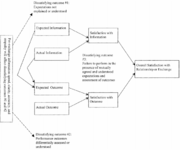Stakeholder Expectations Management
(→The importance of expectation in stakeholder satisfaction) |
|||
| Line 12: | Line 12: | ||
=The importance of expectation in stakeholder satisfaction= | =The importance of expectation in stakeholder satisfaction= | ||
| − | [[File:Stakeholder_satisfaction_model.png | + | [[File:Stakeholder_satisfaction_model.png|thumb|'''Figure 2:''' Stakeholder satisfaction model Source: Strong, K., Ringer, R., & Taylor, S. (2001). THE* Rules of Stakeholder Satisfaction (* Timeliness, Honesty, Empathy). Journal of Business Ethics, 32(3), 219-230. Retrieved from http://www.jstor.org/stable/25074570]] |
=Tools= | =Tools= | ||
Revision as of 13:47, 11 September 2016
Contents |
Abstract
Stakeholder satisfaction is a main factor in a project success. Therefore, for a project manager is vital to have under control the satisfaction of the different stakeholders.
Stakeholder satisfaction is impacted by multiple factors during a project and it can be hard to directly manage it, but it can be improved by managing and aligning the stakeholder expectations. In fact as illustrated by the expectancy disconfirmation model the stakeholder satisfaction is given by the discrepancy between the perceived performance of and the prior expectations about the outcomes.
Expectations usually differ between the different parties in a project and as the number of stakeholders arises aligning becomes more and more difficult.
This article will present a set of tools to evaluate and align stakeholder expectations, both in the planning and execution phases. The tools will focus on stakeholder identification and categorization and on communications strategies.
Project management and stakeholder management
The importance of expectation in stakeholder satisfaction
